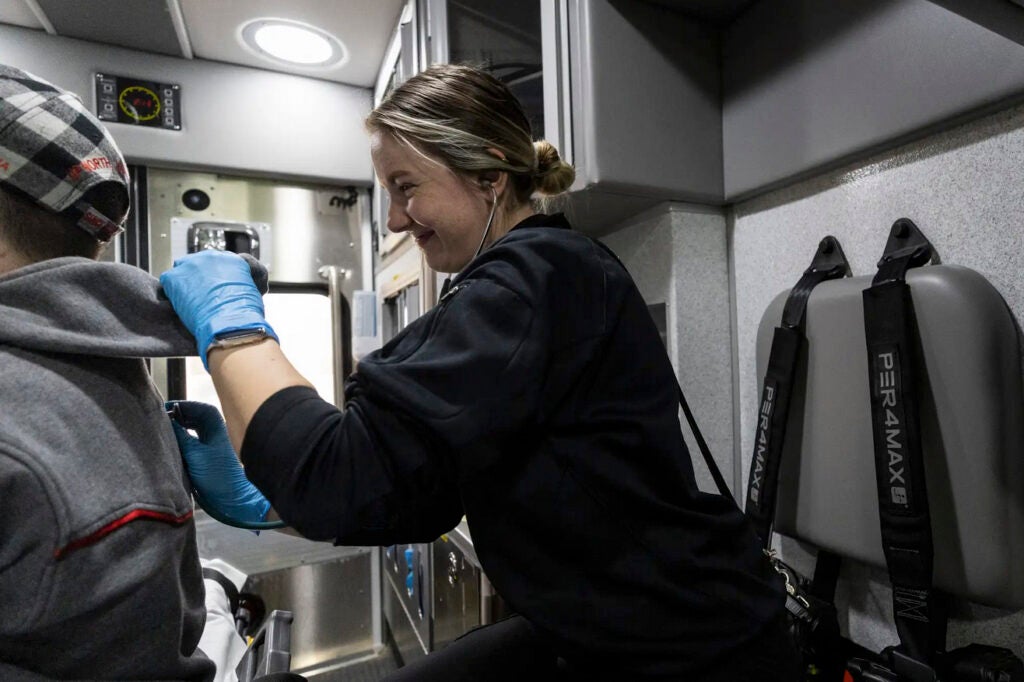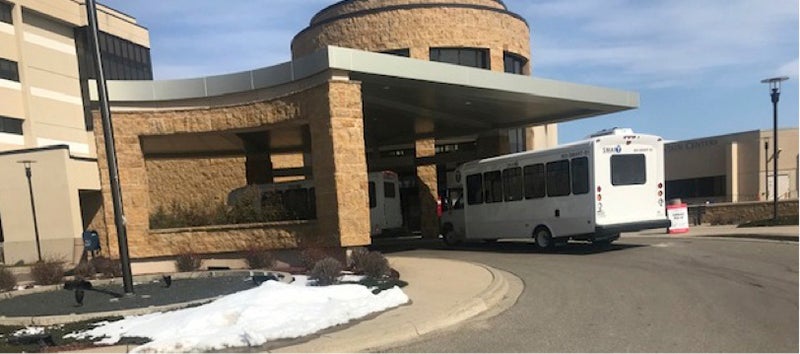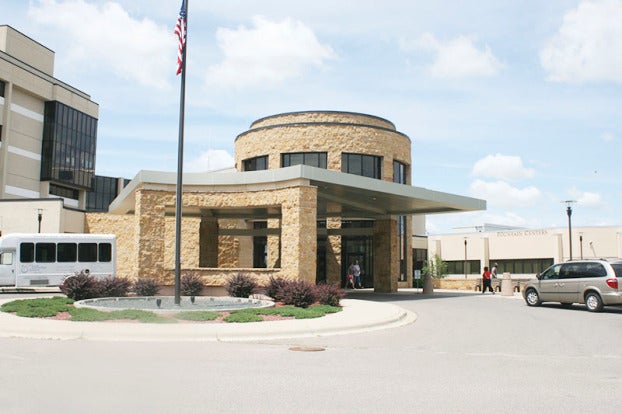Minnesota’s rural ambulance providers look to state Capitol for their own lifeline
Published 9:00 am Friday, April 5, 2024

- Dodge Center Ambulance emergency medical technician Brooke Yennie checks a patient’s breathing during a call near neighboring Kasson on March 29. Ben Hovland/MPR News
|
Getting your Trinity Audio player ready...
|
By Ellie Roth, Minnesota Public Radio News
For Dodge Center emergency medical technician Brooke Yennie, her ambulance is a vessel.
“We can be on the truck and we could bring life into it, and we can be here when life is going out,” Yennie said, “So many stages of life come through here.”
The Dodge Center Ambulance rig she’s worked on for the past four years is a mini emergency room on wheels. Cupboards and drawers are stuffed to the brim with IVs, breathing tubes, medicine and an entire bag filled with everything Yennie would use to deliver a baby on the truck (she’s done it twice).
Dodge Center, a city of about 2,800 people, is 20 miles west of Rochester. But Dodge Center Ambulance covers about 175 square miles.
Yennie is the kind of highly trained medical professional desperately needed in communities, especially those some distance from major health systems. But in many parts of rural Minnesota, ambulance services are at risk of closing their doors.
Rural ambulance services in Minnesota say they are in crisis. Ambulance services rely on being able to bill a patient’s insurance, but that depends on whether they transport that patient to the hospital. In Dodge Center, many times EMTs and paramedics are responding to calls that don’t require hospitalization.
Ambulance services often fail to recover the actual costs of providing their services. According to a report from the EMS regulatory board, ambulance services collectively received $763 million less from insurance companies than the charges they had billed in 2023. The majority of that deficit came from publicly funded insurance programs like Medicare and Medicaid.
On top of that, ambulance services rely heavily on volunteer EMTs and paramedics. The statewide volunteer subsidy was over $55 million for 2023, according to an analysis done by the regulatory board. But volunteerism rates are on the decline.
“Low federal and insurance reimbursement rates, an aging workforce, unsustainable volunteer staffing models and increased operating costs are threatening the ability of local governments and other providers to ensure the health and safety of communities,” St. Joseph Mayor Rick Schultz, president of the Coalition of Greater Minnesota Cities, wrote to lawmakers and others on an EMS task force earlier this year.
This year, EMS services could secure funding in the state’s budget. There are several bills at the Capitol that could provide up to $100 million.
Minnesota’s EMS Regulatory Board has identified a $122 million funding need from the state in order to continue operating at present levels. This number is based on the statewide deficit for ambulance service costs.
In a proposed budget from Gov. Tim Walz and other DFL leaders published last month, rural EMS funding only accounts for $16 million of total new spending. Lawmakers from both parties are pushing the state to spend more.
“I would say within a year, we’re going to see services closing, probably sooner than that,” said Dodge Center paramedic John Fox. “They’re probably holding on just now to see if this money comes through.”
Forty of the 47 staff members at Dodge Center Ambulance are volunteers. Those volunteers donated nearly 15,000 hours at minimal compensation, which interim ambulance director AJ Gengler said saved the operation around $400,000 in labor costs.
“Right now, that’s working for us, but what does that look like 10 years from now? It’s not sustainable,” Gengler said.
Because of a lack of resources and staff, Dodge Center often has to cover for neighboring ambulance services. EMTs sometimes have to drive 30 or 40 minutes to respond to a call. In other areas of the state, those response times are even longer. In northern Minnesota, Virginia’s ambulance service covers an area of roughly 600 square miles.
“I think a lot of people don’t understand they’re at risk for being an ambulance desert,” Yennie said. “It’s when those true emergencies have happened — like cardiac arrest or your child is choking — that you need an ambulance. And you would want one that’s obviously within 10, maybe five, minutes.”
At some times of the day, Dodge Center ambulance is the only health care facility in Dodge County. There’s a community clinic in Dodge Center that’s only open three days a week and a Mayo Clinic in Kasson that operates during normal business hours.
“There is no other health care, there’s no emergency department, there is no other clinic,” Fox said. “After hours, we are it.”
Part of the reason it’s been so difficult for ambulance services to secure funding is because they are not considered essential services, like a city’s police or fire department. In the 1960s, when ambulances first started appearing in cities around the country, they were considered “glorified taxi cabs” with the sole purpose of transporting patients to hospitals.
Now, paramedics and EMTs man the ambulances and can deliver life-saving care on the side of a highway, in a patient’s house or on the way to the hospital. They can save patients thousands of dollars by avoiding expensive emergency room visits.
Ambulance services do not see the $120 million they are requesting as a long-term solution, but rather as a band-aid to ensure that much-needed services in rural Minnesota can stay open. They’ll know by the middle of May whether the money is coming through, how much it is and what eligibility rules are put in place.
Long-term solutions are also being discussed.
Stakeholders are also pushing for other bills to give EMS services more latitude and ability to capture available federal funds. There are also proposals designed to get more EMTs certified.
The Office of the Legislative Auditor studied the sector in 2022 and laid out a slate of recommendations, including changes to the Emergency Medical Services Regulatory Board. Auditors pointed to disparities tied to how old ambulance services were and the level of local government control exists.
Locally, Dodge Center ambulance is exploring other options to continue funding the ambulance services. A solution could be creating a special tax district, which would involve a tax levy for the ambulance service for each community served. Officials have been working closely with the cities and townships in the area of Dodge County that they serve.
“All of us out here are doing the best we can do. We’re doing really good work, we are not missing calls,” Fox said. “We are getting it done, but we just need some help to do that.”





